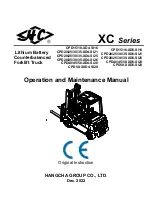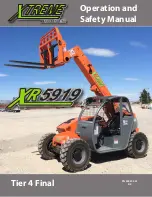
8
11
S A F E T Y I N S T R U C T I O N S
(continued)
OPERATIONAL SAFETY (continued)
For operator safety, always keep load in front of power unit. NEVER position load back over operator. ALWAYS
BE CAREFUL!
Beware of lift clearance when raising loader to maximum height.
Keep alert and watch the rear as well as the front when working with the loader.
Beware of low electrical wires when loader is raised. Serious injury or death can result if contact is made.
Before you operate any equipment, check over all pins, bolts and connections to be sure all are securely in
place. Replace any damaged or worn parts immediately.
Do not work under a raised loader unless it is securely blocked or held in position. Do not depend on the power
unit hydraulic system to hold the implement in place.
Operate the loader controls smoothly, avoiding jerky operation. Stop loader gradually when lowering or lifting
loads.
When handling material on a slope, always approach the material with the power unit facing uphill.
Only use a power unit equipped with a ROPS cab or rollover protective structure.
When stacking material, ALWAYS MAKE SURE MATERIAL IS PLACED SO THE STACK IS STABLE.
Keep all bystanders at a safe distance. REMEMBER FALLING ITEMS CAN ROLL OR TUMBLE.
Do not handle loads that exceed the weight limitations of the loader.
Carry the loads slowly and as low as possible to the ground. Avoid excessive speed during operation.
S A F E T Y I N S T R U C T I O N S
(continued)
Good maintenance is your responsibility. Poor maintenance is an invitation to trouble.
Follow good shop practices.
- Keep service area clean and dry.
- Be sure electrical outlets and tools are properly grounded.
- Use adequate light for the job at hand.
Make sure there is plenty of ventilation. Never operate the engine of the towing vehicle in a closed building.
The exhaust fumes may cause asphyxiation.
Before working on this machine, drive to a level area, disengage the PTO, lower implement or loader (or if
working underneath, raise and block securely), shut off the engine, relieve all hydraulic pressure, set the
brakes, and remove the ignition keys.
Be certain all moving parts on attachments have come to a complete stop before attempting to perform
maintenance.
Never work under equipment unless it is blocked securely. Never depend on hydraulic system to keep imple-
ment in raised position.
Always use personal protection devices such as eye, hand and hearing protectors, when performing any
service or maintenance.
Keep all persons away from operator control area while performing adjustments, service, or maintenance.
Periodically tighten all bolts, nuts and screws and check that all cotter pins are properly installed to ensure unit
is in a safe condition.
When completing a maintenance or service function, make sure all safety shields and devices are installed
before placing unit in service.
Openings in the skin and minor cuts are susceptible to infection from hydraulic fluid. If injured by escaping
hydraulic fluid, see a doctor at once. Gangrene and death can result. Without immediate medical treatment,
serious infection and reactions can occur.
MAINTENANCE SAFETY
























